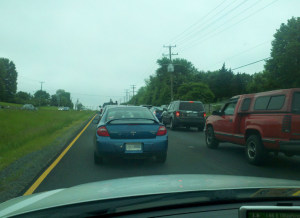
It wasn’t that long ago that traffic in the Northern Virginia suburbs of Washington, DC, followed a pretty standard pattern. On weekday mornings, the backups headed toward the city. On weekday afternoons, they headed out of the city. On weekends, there wasn’t much traffic at all.
Not anymore.
Natural changes to the region’s character—namely, that many of us now live in one suburb and work in another—have largely eliminated the directional pattern. It is almost as common to find backups heading in the opposite direction they used to, or miring-up roads that don’t even head in or out of the city anyway. Once-innovative ideas like the shoulder-lane on Interstate 66, which were designed to give the ‘rush hour’ side an extra lane, now only serve to create artificial backups heading in the opposite direction where they have one less lane than they ought to.
In addition, decades of neglect and under-funding for the DC metro area’s transportation infrastructure have made it so, in some places, it is rush hour almost all the time. This photo was taken on U.S. Route 50 (Lee Jackson Memorial Highway) near Greenbriar this last Saturday. Saturday! Each year, this becomes more the norm. Our road network is now borderline insufficient for Saturday traffic, and it is so grossly insufficient for rush hour traffic that it would be comical if it didn’t have such astronomically high costs in fuel, pollution, productivity, and quality of life.
“Take mass transit,” I hear some of you say. Well, many of us would . . . if it were a viable option. As it is, there is no mass transit available at all where I live, and my office is only accessible by the Fairfax Connector bus system (which Fairfax County established after MetroBus failed to expand service into new suburbs). The MetroRail system was designed for the bygone paradigm of “work in the city, live in the suburbs,” and, as such, is useless for the vast majority of the area’s residents. We need a ‘spiderweb’ system layout, not a ‘hub and spoke’ layout, and the Washington Metropolitan Area Transit Authority (WMATA) has done basically nothing to expand its Metro bus and rail systems to meet our current needs. It is no wonder that their ridership, which has trended gently upwards, has increased at a mere fraction of the rate of the overall population increase.
I posit no solutions in this brief piece. I’m not even sure there is a solution anymore, short of a mind-boggling influx in money from the various levels of government involved—governments that cannot afford such an investment now anyway. It would cost billions upon billions upon billions of dollars to get our road and mass transit infrastructure caught-up to where they ought to be today, let alone get them ready for the future. As for big, notable projects like the I-95/395/495 mixing bowl, Wilson Bridge, and MetroRail to Dulles Airport? They are all far too little, and more than a quarter-century too late.

